 What are Zero Energy Passive Houses?
What are Zero Energy Passive Houses?Airtightness Strategies for Passive House BuildingsWhen renovating a house to passive standards, it is crucial to consider the elimination of thermal bridges. This involves meticulous attention to detail in the construction process to ensure that heat is not conducted through structural elements, causing energy loss. By employing advanced construction techniques and materials, such as thermal break materials and continuous insulation, thermal bridging can be minimised, contributing to the overall energy efficiency of the renovated home.
Thermal BridgeFree Construction Thermal bridge-free construction plays a crucial role in passive house design, ensuring optimal energy efficiency and comfort for occupants. By eliminating thermal bridges, which are areas of high heat transfer within a building's structure, heat loss is significantly reduced, resulting in lower energy consumption and cost savings. This construction technique involves careful planning and meticulous detailing to create a continuous thermal envelope that minimises heat loss and maintains a consistent indoor temperature throughout the year.Table Of ContentsPassive House design principles have gained increasing popularity for their remarkable energy efficiency across various climates. Case studies of Passive Houses around the world provide concrete evidence of the effectiveness of this approach. For example, in Melbourne, Australia, a Passive House was constructed using high-qualit
Airtightness Planning and Implementation
When it comes to airtightness planning and implementation in Passive House buildings, meticulous attention to detail is crucial. The process begins with a well-thought-out design that integrates airtightness measures seamlessly into the overall building structure. Architects and builders must work collaboratively to ensure that every component, from windows and doors to insulation and ventilation systems, contributes to the airtightness of the building envelope. Utilising quality materials and following best practices during construction are essential to achieving the desired level of airtightness.Related Links
ur (ACH) rate of 0.6 or less at 50 Pascals. This stringent target necessitates meticulous planning and implementation of airtightness measures throughout the building envelope. From selecting appropriate air barrier materials to ensuring proper installation techniques, addressing airtightness early in the design process is crucial for compliance with Passive House standards.
Related LinksTerms of Use
Thermal Bridging Prevention in Passive House InsulationImportance of Proper Insulation in Passive House Construction
Sustainable and Eco-friendly Insulation Options for Passive House
Insulation Installation Techniques for Passive House ConstructionPrivacy Policy
Airtightness Testing and Certification for Passive House Buildings